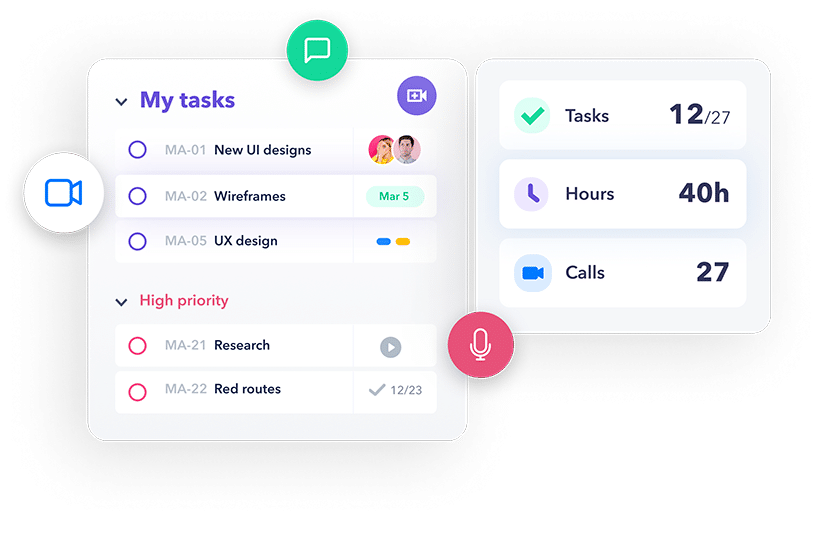Efficient team communication and team collaboration are the most important traits of successful teams. However, hybrid and remote work make team communication much more challenging, and organizations need to find ways to make it work.
Focusing on team communication management can pay rich dividends to an organization. By building better team communication habits, you can improve a team’s agility, productivity, engagement, collaboration, and focus. It will also ensure a more equitable distribution of work.
While the benefits are obvious, managing team communication can still be challenging primarily because of the added realities of remote and hybrid work. Plus, companies are now dealing with projects of increasing complexity and scale. But there are still some proven ways to improve team communication management.
12 ways to improve team communication
If you’re a team leader, here are 12 suggestions for effectively managing team communication.
1. Select the right medium
There has been a proliferation of communication channels over the last two decades. But it also means that managers are uncertain of which medium to use to improve team communication. Should it be an email, meeting, text message, or video call?
The way to identify the right medium is to ask yourself how you would prefer to receive that information. If it’s urgent and needs only a limited number of participants, a phone call could be better. If it has additional documents, maybe a dedicated messaging platform is the answer. Make sure that the channel you select matches the importance and context of the message.
2. Keep it transparent
Clarity improves team communication. No matter how big or small the project, team members need to have a transparent workflow. Everyone should know their individual and collective responsibilities, deadlines, and internal review timelines. Nobody should have to chase down a manager for clarifications or to seek additional resources.
Transparency through a specialized project management tool such as Heycollab ensures that there will be little friction in the process. Since everyone’s on the same page, tasks will be completed faster. Managers won’t have to disrupt the deep work sessions of team members for needless meetings. Overall, it significantly improves collaboration and productivity.

3. Keep all communication purposeful
A crucial aspect of managing team communication is making it focused and relevant. Quantity doesn’t equal quality. What you need is for each interaction to have a clearly defined purpose. This eliminates confusion, rumors, and conflicts among team members.
Whether it’s an email, phone call, meeting, text, or town hall, be clear on the purpose. Who is your primary audience? What do you want them to do? Is there a deadline for the activity? Do they have the resources to complete the task? Will they need clarifications and if so, what’s the process for that? Answering these at the outset will save you precious time.
4. Explain by providing context
Assigning responsibilities is only half the job of a team leader. Asking your team members to do something won’t give them the full context. You should convey why it’s important that they do the task within the specified deadline. Remember that not everyone in your team would know the reason for executing the project.
When the team understands why they have to do the job, there will be greater involvement. Employees will feel encouraged because they can see the value of their work. Once they find out how their contributions fit into the larger plan, there will be fewer delays and greater ownership of work.
5. Assign roles
Team communication will improve when employees know their precise roles within teams. While improving transparency, it also makes sure that the team is not overloaded and that individuals are assigned tasks that match their skills.
By assigning roles, you’re also saving time. Team members will know whom they should contact for any clarifications. Managers won’t have to answer all queries or call for unnecessary meetings. It also ensures that people can share their work with the right person and get timely feedback and approval. This is how you execute projects within deadlines.
6. Set goals for subtasks
Leaders know the importance of setting goals for projects. But it’s equally important to define the goals for subtasks. If employees don’t know why they’re doing a particular task, they might believe that the job is not important to the project. This decreases engagement and lowers the quality of the product.
An effective way to address this is by writing down the specific goals of subtasks. Before you call a meeting or send a message or an email, note down the purpose of the job, its context, the skills it needs, and its timeline. Anyone reading the message should know everything there’s to know about the subtask and its significance to the project.
7. Establish communication etiquette
One of the biggest problems in team communication is that well, there’s too much of it. And most of it is pointless. You have unnecessary meetings, endless email threads, and reply-all messages, just to mention a few. There’s too much duplication of content, which makes it difficult for people to find the right message. All of it wastes time and energy.
The solution? Set communication etiquette for your organization and its teams. Specify what message can be sent as a message or email and what needs a meeting. Mark only relevant individuals in your communication and invite only the right people for meetings. Have clear agendas when you meet and share the minutes with everyone concerned.
8. Get regular progress updates
You don’t want to be surprised at the end of the timeline with an update that your project is behind schedule. You don’t want a last-minute query on an important question. What you do need are regular updates about the project and its subtasks.
Have a schedule for progress updates. These should be only for the concerned individuals who need to give approval or feedback. Don’t clog everyone’s mailboxes with project emails. If anyone wants additional information or more resources, there should be a mechanism to seamlessly provide that. This is particularly important for remote and hybrid teams.

9. Resolve conflicts early
For efficient team communication, managers should strive to resolve conflicts early on. In any team, particularly for complex projects or for those tasks where individuals are working together for the first time, there could be disagreements or conflicts. Managers shouldn’t ignore them or allow these problems to fester.
Wherever there’s a conflict, listen to both sides objectively. Discourage personal accusations and try to make it about work. When you provide a resolution, give a framework with action points. It’s also important to give these in writing so that the concerned individuals know specifically what they should and shouldn’t do.
10. Prioritize one-on-one interactions
To improve team communication management, focus on how you communicate with the individuals in the team. Not all communication needs to be through email or text. Some of them can – and should be – through direct interactions. While the other channels are impersonal, these conversations are more personal and therefore, impactful.
There will be important or sensitive issues that require one-on-one interactions. These will help you avoid confusion and miscommunication. You could hold these interactions in person, over a phone call, or through video chat. This will save you time and show the individual that you respect their time. Organizations that are successful in managing team communication know that these interactions also improve trust in the system.
11. Customize your team communication
Different individuals prefer different types of communication. There could be extroverts in your team who look forward to meetings since they find it easy to speak in public forums. The introverts might be shy to raise their opinion or give feedback in meetings. For managers, this means that there can be no one-size-fits-all approach to team communication.
Take the time to understand employee preferences. If an individual prefers emails with detailed information, use that to communicate with them. If someone else likes to have direct meetings, that could be the right option for them. This also helps you develop an inclusive culture that cares for your employees.
12. Regularly track your communication
Just like performance reviews, businesses should also evaluate their team communication management. This will bring to light problems and opportunities in the way you engage within the system. You might discover that there’s an avoidable repetition of messaging or that, important topics get lost in the sheer quantity of messages.
Such communication reviews should ideally start at the team level and then move up the value chain. Keep in mind that since team communication needs to be customized, what works for one domain may not be the right solution for another.

In short
The quality of your team communication will determine how productive, innovative, and collaborative your organization will be. Heycollab is a project management tool built for teams like yours. With a free 14-day trial, you can try out all the cool features. To get started, visit https://heycollab.com/

